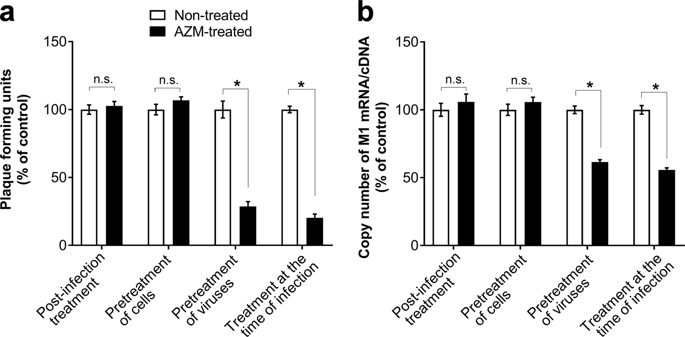当前位置:
X-MOL 学术
›
J. Antibiot.
›
论文详情
Our official English website, www.x-mol.net, welcomes your
feedback! (Note: you will need to create a separate account there.)
Azithromycin, a 15-membered macrolide antibiotic, inhibits influenza A(H1N1)pdm09 virus infection by interfering with virus internalization process.
The Journal of Antibiotics ( IF 2.1 ) Pub Date : 2019-07-12 , DOI: 10.1038/s41429-019-0204-x Dat Huu Tran 1, 2 , Ryuichi Sugamata 1, 2, 3 , Tomoyasu Hirose 4 , Shoichi Suzuki 1, 2, 3 , Yoshihiko Noguchi 4 , Akihiro Sugawara 4, 5 , Fuyu Ito 2 , Tomoko Yamamoto 2 , Shoji Kawachi 2, 3 , Kiyoko S Akagawa 4 , Satoshi Ōmura 4 , Toshiaki Sunazuka 4 , Naoki Ito 6 , Masakazu Mimaki 6 , Kazuo Suzuki 1, 2, 3
The Journal of Antibiotics ( IF 2.1 ) Pub Date : 2019-07-12 , DOI: 10.1038/s41429-019-0204-x Dat Huu Tran 1, 2 , Ryuichi Sugamata 1, 2, 3 , Tomoyasu Hirose 4 , Shoichi Suzuki 1, 2, 3 , Yoshihiko Noguchi 4 , Akihiro Sugawara 4, 5 , Fuyu Ito 2 , Tomoko Yamamoto 2 , Shoji Kawachi 2, 3 , Kiyoko S Akagawa 4 , Satoshi Ōmura 4 , Toshiaki Sunazuka 4 , Naoki Ito 6 , Masakazu Mimaki 6 , Kazuo Suzuki 1, 2, 3
Affiliation

|
The pandemic influenza 2009 (A(H1N1)pdm09) virus currently causes seasonal and annual epidemic outbreaks. The widespread use of anti-influenza drugs such as neuraminidase and matrix protein 2 (M2) channel inhibitors has resulted in the emergence of drug-resistant influenza viruses. In this study, we aimed to determine the anti-influenza A(H1N1)pdm09 virus activity of azithromycin, a re-positioned macrolide antibiotic with potential as a new anti-influenza candidate, and to elucidate its underlying mechanisms of action. We performed in vitro and in vivo studies to address this. Our in vitro approaches indicated that progeny virus replication was remarkably inhibited by treating viruses with azithromycin before infection; however, azithromycin administration after infection did not affect this process. We next investigated the steps inhibited by azithromycin during virus invasion. Azithromycin did not affect attachment of viruses onto the cell surface, but blocked internalization into host cells during the early phase of infection. We further demonstrated that azithromycin targeted newly budded progeny virus from the host cells and inactivated their endocytic activity. This unique inhibitory mechanism has not been observed for other anti-influenza drugs, indicating the potential activity of azithromycin before and after influenza virus infection. Considering these in vitro observations, we administered azithromycin intranasally to mice infected with A(H1N1)pdm09 virus. Single intranasal azithromycin treatment successfully reduced viral load in the lungs and relieved hypothermia, which was induced by infection. Our findings indicate the possibility that azithromycin could be an effective macrolide for the treatment of human influenza.
中文翻译:

阿奇霉素是一种15元大环内酯类抗生素,通过干扰病毒内在化过程来抑制A(H1N1)pdm09流感病毒感染。
当前,2009年大流行性流感(A(H1N1)pdm09)病毒引起季节性和年度性流行病暴发。抗流感药物,例如神经氨酸酶和基质蛋白2(M2)通道抑制剂的广泛使用,导致了耐药性流感病毒的出现。在这项研究中,我们旨在确定阿奇霉素的抗流感A(H1N1)pdm09病毒活性,阿奇霉素是一种重新定位的大环内酯类抗生素,具有作为新的抗流感候选药物的潜力,并阐明其潜在的作用机理。我们进行了体外和体内研究来解决这个问题。我们的体外方法表明,感染前用阿奇霉素处理病毒可显着抑制子代病毒的复制。但是,感染后给予阿奇霉素并不影响这一过程。接下来,我们研究了在病毒入侵过程中阿奇霉素抑制的步骤。阿奇霉素不影响病毒在细胞表面的附着,但在感染的早期阶段阻止了宿主细胞的内在化。我们进一步证明,阿奇霉素靶向宿主细胞中新发芽的子代病毒并使其内吞活性失活。对于其他抗流感药物,尚未观察到这种独特的抑制机制,表明在流感病毒感染之前和之后,阿奇霉素具有潜在的活性。考虑到这些体外观察结果,我们向经A(H1N1)pdm09病毒感染的小鼠鼻内施用阿奇霉素。鼻内使用阿奇霉素单次治疗可成功降低肺部病毒载量并缓解由感染引起的体温过低。
更新日期:2019-11-18
中文翻译:

阿奇霉素是一种15元大环内酯类抗生素,通过干扰病毒内在化过程来抑制A(H1N1)pdm09流感病毒感染。
当前,2009年大流行性流感(A(H1N1)pdm09)病毒引起季节性和年度性流行病暴发。抗流感药物,例如神经氨酸酶和基质蛋白2(M2)通道抑制剂的广泛使用,导致了耐药性流感病毒的出现。在这项研究中,我们旨在确定阿奇霉素的抗流感A(H1N1)pdm09病毒活性,阿奇霉素是一种重新定位的大环内酯类抗生素,具有作为新的抗流感候选药物的潜力,并阐明其潜在的作用机理。我们进行了体外和体内研究来解决这个问题。我们的体外方法表明,感染前用阿奇霉素处理病毒可显着抑制子代病毒的复制。但是,感染后给予阿奇霉素并不影响这一过程。接下来,我们研究了在病毒入侵过程中阿奇霉素抑制的步骤。阿奇霉素不影响病毒在细胞表面的附着,但在感染的早期阶段阻止了宿主细胞的内在化。我们进一步证明,阿奇霉素靶向宿主细胞中新发芽的子代病毒并使其内吞活性失活。对于其他抗流感药物,尚未观察到这种独特的抑制机制,表明在流感病毒感染之前和之后,阿奇霉素具有潜在的活性。考虑到这些体外观察结果,我们向经A(H1N1)pdm09病毒感染的小鼠鼻内施用阿奇霉素。鼻内使用阿奇霉素单次治疗可成功降低肺部病毒载量并缓解由感染引起的体温过低。











































 京公网安备 11010802027423号
京公网安备 11010802027423号